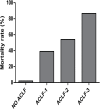Comparison of current diagnostic criteria for acute-on-chronic liver failure
- PMID: 25785855
- PMCID: PMC4364726
- DOI: 10.1371/journal.pone.0122158
Comparison of current diagnostic criteria for acute-on-chronic liver failure
Erratum in
-
Correction: Comparison of Current Diagnostic Criteria for Acute-On-Chronic Liver Failure.PLoS One. 2015 Jul 20;10(7):e0133817. doi: 10.1371/journal.pone.0133817. eCollection 2015. PLoS One. 2015. PMID: 26193100 Free PMC article.
Abstract
Background and aims: Currently, acute-on-chronic liver failure (ACLF) has been defined differently by Asia-Pacific Association for the Study of the Liver (APASL) and Chinese Medical Association (CMA) in the East, as well as EASL-Chronic Liver Failure (EASL-CLIF) Consortium in the West. This study aimed to compare current different diagnostic criteria for ACLF and to determine predictors of the progression into post-enrollment EASL-CLIF ACLF from ACLF at enrollment defined by APASL alone or by both APASL and CMA but not by EASL-CLIF Consortium.
Methods: We retrospectively analyzed clinical data from 394 eligible cirrhotic patients fulfilling at least APASL criteria for ACLF at enrollment. Patient survival was estimated by Kaplan-Meier analysis and subsequently compared by log-rank test. Independent predictors of disease progression were determined using univariate analysis and multivariate Cox regression analysis.
Results: The 90-day mortality rate was 13.1% in patients with ACLF at enrollment defined by APASL alone, 25.3% in patients with ACLF at enrollment defined by both APASL and CMA but not EASL-CLIF Consortium, and 59.3% in patients with ACLF at enrollment defined by EASL-CLIF Consortium in addition to APASL. Baseline Chronic Liver Failure-Sequential Organ Failure Assessment (CLIF-SOFA) score, and the maximum rising rates of CLIF-SOFA score, Model for End-Stage Liver Disease-Sodium (MELD-Na) score and total bilirubin were independent predictors of progression into post-enrollment EASL-CLIF ACLF from ACLF at enrollment defined by APASL alone or by both APASL and CMA but not by EASL-CLIF Consortium.
Conclusion: Different diagnostic criteria for ACLF caused different patient prognosis. So, it is imperative to formulate a unifying diagnostic criteria for ACLF worldwide, thus attaining early identification and treatment, and eventual improvement in survival of ACLF patients. Baseline CLIF-SOFA score, and the maximum rising rates of CLIF-SOFA score, MELD-Na score and total bilirubin may early predict post-enrollment development of EASL-CLIF ACLF.
Conflict of interest statement
Figures




Similar articles
-
Chronic Liver Failure-Sequential Organ Failure Assessment is better than the Asia-Pacific Association for the Study of Liver criteria for defining acute-on-chronic liver failure and predicting outcome.World J Gastroenterol. 2014 Oct 28;20(40):14934-41. doi: 10.3748/wjg.v20.i40.14934. World J Gastroenterol. 2014. PMID: 25356054 Free PMC article.
-
Transplantation for EASL-CLIF and APASL acute-on-chronic liver failure (ACLF) patients: The TEA cohort to evaluate long-term post-Transplant outcomes.EClinicalMedicine. 2022 Jun 4;49:101476. doi: 10.1016/j.eclinm.2022.101476. eCollection 2022 Jul. EClinicalMedicine. 2022. PMID: 35747194 Free PMC article.
-
Complications constitute a major risk factor for mortality in hepatitis B virus-related acute-on-chronic liver failure patients: a multi-national study from the Asia-Pacific region.Hepatol Int. 2019 Nov;13(6):695-705. doi: 10.1007/s12072-019-09992-x. Epub 2019 Oct 24. Hepatol Int. 2019. PMID: 31650510
-
Acute-on-chronic liver failure (ACLF): the 'Kyoto Consensus'-steps from Asia.Hepatol Int. 2025 Feb;19(1):1-69. doi: 10.1007/s12072-024-10773-4. Epub 2025 Feb 17. Hepatol Int. 2025. PMID: 39961976 Free PMC article. Review.
-
Toward a Better Definition of Acute-on-Chronic Liver Failure.J Clin Exp Hepatol. 2017 Sep;7(3):262-265. doi: 10.1016/j.jceh.2017.05.002. Epub 2017 May 15. J Clin Exp Hepatol. 2017. PMID: 28970714 Free PMC article. Review.
Cited by
-
Predictors of early mortality among patients with acute-on-chronic liver failure.JGH Open. 2021 May 19;5(6):686-694. doi: 10.1002/jgh3.12557. eCollection 2021 Jun. JGH Open. 2021. PMID: 34124387 Free PMC article.
-
Acute-on-chronic liver failure is independently associated with higher mortality for cirrhotic patients with acute esophageal variceal hemorrhage: Retrospective cohort study.World J Clin Cases. 2023 Jun 16;11(17):4003-4018. doi: 10.12998/wjcc.v11.i17.4003. World J Clin Cases. 2023. PMID: 37388802 Free PMC article.
-
Neutrophil Extracellular Trap Scores Predict 90-Day Mortality in Hepatitis B-Related Acute-on-Chronic Liver Failure.Biomedicines. 2024 Sep 9;12(9):2048. doi: 10.3390/biomedicines12092048. Biomedicines. 2024. PMID: 39335563 Free PMC article.
-
Circulating histones are major mediators of systemic inflammation and cellular injury in patients with acute liver failure.Cell Death Dis. 2016 Sep 29;7(9):e2391. doi: 10.1038/cddis.2016.303. Cell Death Dis. 2016. PMID: 27685635 Free PMC article.
-
Therapeutic Effect and Safety of Granulocyte Colony-Stimulating Factor Therapy for Acute-On-Chronic Liver Failure: A Systematic Review and Meta-Analysis of Randomized Controlled Trials.Front Med (Lausanne). 2021 Nov 16;8:784240. doi: 10.3389/fmed.2021.784240. eCollection 2021. Front Med (Lausanne). 2021. PMID: 34869505 Free PMC article.
References
-
- Sarin SK, Kedarisetty CK, Abbas Z, Amarapurkar D, Bihari C, Garg H, et al. Acute-on-chronic liver failure: consensus recommendations of the Asian Pacific Association for the Study of the Liver (APASL) 2014. Hepatol Int. 2014;8: 453–471. - PubMed
-
- Liver F, Artificial Liver Group CSoIDCMA, Severe Liver D, Artificial Liver Group CSoHCMA. [Diagnostic and treatment guidelines for liver failure (2012 version)]. Zhonghua Gan Zang Bing Za Zhi. 2013;21: 177–183. - PubMed
Publication types
MeSH terms
LinkOut - more resources
Full Text Sources
Other Literature Sources

